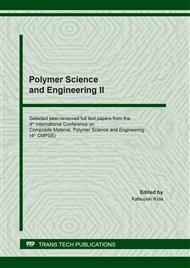[1]
A. L. Andrady, Plastics and The Environment, Wiley Interscience, New Jersey, (2003).
Google Scholar
[2]
R. Bai, M. Sutanto, The Practice and Challenges of Solid Waste Management in Singapore. Waste Management, 22 (2002), pp.557-567.
DOI: 10.1016/s0956-053x(02)00014-4
Google Scholar
[3]
R. Bogucka, I. Kosińska, P. H. Brunner, Setting Priorities in Plastic Waste Management-Lessons Learned from Material Flow Analysis in Austria and Poland. Polimery, 52 (2008).
DOI: 10.14314/polimery.2007.055
Google Scholar
[4]
S. Bringezu and Y. Moriguchi, Material Flow Analysis, in: R. U. Ayres, L. W. Ayres, A Hand Book For Industrial Ecology, Edward Elgar Publishing Limited, Cheltenham, 2018, pp.79-90.
Google Scholar
[5]
J. W. Creswell, Qualitative Inquiry and Research Design: Choosing Among Five Approaches (3rd ed.), Sage Publications, Thousand Oaks CA, (2012).
Google Scholar
[6]
H. Dahlbo, V. Poliakova, V. Mylläri, O. Sahimaa, R. Anderson, Recycling Potential of Post-Consumer Plastic Packaging Waste in Finland. Waste Management. 71 (2018), pp.52-61.
DOI: 10.1016/j.wasman.2017.10.033
Google Scholar
[7]
EEA, Better management of municipal waste will reduce greenhouse gas emissions. Copenhagen, Denmark: European Environment Agency, (2008).
Google Scholar
[8]
Ellen McArthur Foundation, The new plastics economy, Rethinking the future of plastics, (2016).
Google Scholar
[9]
D. S. Gabriel, How to Increase Plastic Waste Acceptance for Mechanical Recycling: An Introduction to Material Value Conservation and Its Phenomenon, Key Engineering Materials, 705 (2016), pp.362-367.
DOI: 10.4028/www.scientific.net/kem.705.362
Google Scholar
[10]
FPA, FPA consumer and brand owner sustainability study, (2018).
Google Scholar
[11]
G. Gibbs, Analysing Qualitative Data, Sage Publications, London, (2008).
Google Scholar
[12]
J. Guoqiang, L. Hengjiang, Research on the Quality Chain Management Theory, World Standardization & Quality Management, 2006, p.25-27.
Google Scholar
[13]
J. N. Hahladakis, P. Purnell, E. Iacovidou, C. A. Velis, M. Atseyinku, Post Consumer Plastic Packaging Waste in England: Assessing The Yield of Multiple Collection Recycling Schemes, Waste Management, 75(2018), pp.149-159.
DOI: 10.1016/j.wasman.2018.02.009
Google Scholar
[14]
C.A. Harper, Handbook of Plastic Technologies: The Complete Guide to Properties and Performance, McGraw-Hill, New York, (2006).
Google Scholar
[15]
S. Huysman, J. De Schaepmeester, K. Ragaert, J. Dewulf, S. De Meester, Performance Indicators for A Circular Economy: A Case Study on Post-Industrial Plastic Waste, Resources, Conservation and Recycling, 120 (2017), pp.46-54.
DOI: 10.1016/j.resconrec.2017.01.013
Google Scholar
[16]
O. Horodytska, F. J. Valdés, A. Fullana, Plastic flexible films waste management – A state of art review, Waste Management, 77 (2018), pp.413-425.
DOI: 10.1016/j.wasman.2018.04.023
Google Scholar
[17]
Information on https://kemenperin.go.id.
Google Scholar
[18]
ISO 14044:2006, Environmental Management - Life Cycle Assessment: Requirements and Guidelines, First Edition 2006-07-01, International Organization for Standardization, (2006).
DOI: 10.3403/30290345
Google Scholar
[19]
J. R. Jambeck, R. Geyer, C. Wilcox, T. R. Siegler, M. Perryman, A. Andrady, R. Narayan, K. L. Law, Plastic Waste Inputs from Land into The Ocean, Science, 347 (2015), pp.768-771.
DOI: 10.1126/science.1260352
Google Scholar
[20]
B. G. Mwanza, C. Mbohwa, Drivers to Sustainable Plastic Solid Waste Recycling: A Review, Procedia Manufacturing, 8 (2017), pp.649-656.
DOI: 10.1016/j.promfg.2017.02.083
Google Scholar
[21]
R. Nurcahyo, D.S. Gabriel, W.L. Ikhsan, Repetitive Implementation of Material Value Conservation and its Effects on the Mechanical Properties of Plastic Recycling Products, Materials Science Forum, 936 (2018), pp.116-120.
DOI: 10.4028/www.scientific.net/msf.936.116
Google Scholar
[22]
J. S. Oakland, Total Quality Management and Operational Excellence, fourth ed., Routledge, New York, (2014).
Google Scholar
[23]
A.R. Putri, T. Fujimori, M. Takaoka, Plastic Waste Management in Jakarta, Indonesia: Evaluation of Material Flow and Recycling Scheme, Journal of Material Cycles and Waste Management, 20 (2018), pp.2140-2149.
DOI: 10.1007/s10163-018-0753-2
Google Scholar
[24]
M. E. Porter, Competitive Advantage: Creating and Sustaining Superior Performance, Simon and Schuster, New York, (1985).
Google Scholar
[25]
E. T. Quartey, H. Tosefa, K.A.B. Danquah, I. Obrsalova, Theoretical Framework for Plastic Waste Management in Ghana Through Extended Producer Responsibility: Case of Sachet Water Waste, International Journal of Environmental Research and Public Health, 12(2015), pp.9907-2149.
DOI: 10.3390/ijerph120809907
Google Scholar
[26]
P. Singh, V. P. Sharma, Integrated Plastic Waste Management: Environmental and Improved Health Approaches, Procedia Environmental Sciences, 35 (2016), pp.692-700.
DOI: 10.1016/j.proenv.2016.07.068
Google Scholar
[27]
A. M. Troschinetz, J. R. Mihelcic, Sustainable Recycling of Municipal Solid Waste in Developing Countries, Waste Management, 29 (2009), pp.915-923.
DOI: 10.1016/j.wasman.2008.04.016
Google Scholar
[28]
Worldbank, Solid Waste Management, (2019).
Google Scholar
[29]
Worldwatch Institute, Global Plastic Production Rises, Recycling Lags, (2015).
Google Scholar
[30]
I. S. Zen, C. Siwar, An analysis of household acceptance of curbside recycling scheme in Kuala Lumpur, Malaysia, Habitat International, 47 (2015), pp.248-255.
DOI: 10.1016/j.habitatint.2015.01.014
Google Scholar
[31]
J. Peppard, A. Rylander, From Value Chain to Value Network: Insights for Mobile Operators, European Management Journal, Vol. 24, (2006), 2.
Google Scholar
[32]
R. Kaplinsky, and M. Morris, A Handbook for Value Chain Research, Institute of Development Studies, University of Sussex, Brighton, United Kingdom, (2001).
Google Scholar
[33]
M. E. Porter, What is strategy?,, Harvard Business Review, 74-4 (1996), pp.61-78.
Google Scholar
[34]
D. S. Gabriel, J. Maulana, Impact of Plastic Labelling, Coloring and Printing on Material Value Conservation in the Products of Secondary Recycling. Key Engineering Materials, Vol. 773 (2018), pp.384-389.
DOI: 10.4028/www.scientific.net/kem.773.384
Google Scholar
[35]
D.S. Gabriel, M. Habiburrahman, P.J. Endthen, Material Value Conservation: Development of Design Criteria for Rigid Plastic Packaging. Materials Science Forum, Vol. 936 (2018), pp.110-115.
DOI: 10.4028/www.scientific.net/msf.936.110
Google Scholar
[36]
D. S. Gabriel, D. Isnandar, A. Jeremia, Plastic Packaging Material Value Conservation and Evident of the Consumers' Acceptance. Key Engineering Materials, Vol. 773 (2018), pp.390-395.
DOI: 10.4028/www.scientific.net/kem.773.390
Google Scholar
[37]
A. Blanco, R. Miranda and M.C. Monte, Extending the limits of paper recycling: improvements along the paper value chain. Forest System 22 No.3 (2013), pp.471-483.
DOI: 10.5424/fs/2013223-03677
Google Scholar
[38]
Indonesian Government Regulation, PP No. 101 year (2014).
Google Scholar


